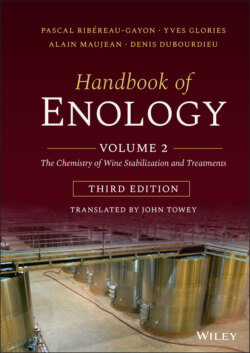Читать книгу Handbook of Enology, Volume 2 - Pascal Ribéreau-Gayon - Страница 2
Table of Contents
Оглавление1 Cover
2 Title Page
3 Copyright Page
4 Foreword
5 Preface to the Second Edition
6 Preface to the First Edition
7 Remarks Concerning the Expression of Certain Parameters of Must and Wine Composition Units Expression of Total Acidity and Volatile Acidity Evaluating the Sugar Concentration of Musts Measurements Using Visible and Ultraviolet Spectrometry
8 PART I: Chemistry of Wine CHAPTER 1: Organic Acids in Wine 1.1 Introduction 1.2 The Main Organic Acids 1.3 Different Types of Acidity 1.4 The Concept of pH and Its Applications 1.5 Tartrate Precipitation Mechanism and Predicting Its Effects 1.6 Tests for Predicting Wine Stability 1.7 Preventing Tartrate Precipitation References CHAPTER 2: Alcohols and Other Volatile Compounds 2.1 Ethanol 2.2 Other Simple Alcohols 2.3 Polyols 2.4 Aliphatic FattyAcids 2.5 Esters 2.6 Miscellaneous Compounds References CHAPTER 3: Carbohydrates 3.1 Introduction 3.2 Glucose and Fructose 3.3 Other Sugars 3.4 Chemical Properties of Sugars 3.5 Sugar Derivatives 3.6 Pectic Substances in Grapes 3.7 Exocellular Polysaccharides from Microorganisms References CHAPTER 4: Dry Extract and Minerals 4.1 Introduction 4.2 Dry Extract 4.3 Ash 4.4 Inorganic Anions 4.5 Inorganic Cations 4.6 Iron and the Iron Casse Mechanism 4.7 Copper and Copper Casse 4.8 Heavy Metals References CHAPTER 5: Nitrogen Compounds 5.1 Introduction 5.2 The Various Forms of Nitrogen 5.3 Amino Acids 5.4 Other Forms of Nitrogen 5.5 Proteins and Protein Haze 5.6 Preventing Protein Haze References CHAPTER 6: Phenolic Compounds 6.1 Introduction 6.2 Types of Substances 6.3 Chemical Properties of Anthocyanins and Tannins 6.4 Anthocyanin and Tannin Assays: Sensory Properties 6.5 Evolution of Anthocyanins and Tannins as Grapes Ripen 6.6 Extracting Tannins and Anthocyanins During Winemaking 6.7 Chemical Reactions Occurring During Bulk and Bottle Aging 6.8 Precipitation of Coloring Matter (Color Stability) 6.9 Origin of the Color of White Wines References CHAPTER 7: Varietal Aroma 7.1 The General Concept of Varietal Aroma 7.2 Terpene Compounds 7.3 C13‐Norisoprenoid Derivatives 7.4 Methoxypyrazines 7.5 Sulfur Compounds with a Thiol Function 7.6 Furanones 7.7 Lactones 7.8 Aromas of American Species References
9 PART II: Wine Stabilization and Treatments CHAPTER 8: Main Sensory Defects: Chemical Nature, Origins and Consequences 8.1 Introduction 8.2 Oxidative Defects 8.3 Effect of Various Forms of Bacterial Spoilage 8.4 Microbiological Origin and Properties of Volatile Phenols 8.5 Cork Taint 8.6 Sulfur Derivatives and Reduction Odors 8.7 Premature Aging of Wine Aroma 8.8 Sensory Defects Associated with Grapes Affected by Various Types of Rot 8.9 MiscellaneousDefects References CHAPTER 9: The Concept of Clarity and Colloidal Phenomena 9.1 Clarity and Stability 9.2 The Colloidal State 9.3 Colloid Reactivity 9.4 Protective Colloids and Gum Arabic Treatment References CHAPTER 10: Clarification and Stabilization Treatments 10.1 Treating Wine 10.2 Sedimentation of Particles in Suspension 10.3 Racking: Role and Techniques 10.4 Theory of Protein Fining 10.5 Tannin–Protein Interactions 10.6 Effect of Fining on the Organoleptic Quality of Wine: Concept of Overfining 10.7 Products Used in Fining 10.8 Fining Techniques 10.9 Bentonite Treatment 10.10 Miscellaneous Clarification Treatments References CHAPTER 11: Clarifying Wine by Filtration and Centrifugation 11.1 Principles of Filtration 11.2 Laws of Filtration 11.3 Methods for Assessing Clarification Quality 11.4 Filtration Equipment and Filter Aids 11.5 How Filter Layers Function 11.6 Filtration Through Diatomaceous Earth (or Kieselguhr) Precoats 11.7 Filtration Through Cellulose‐Based Filter Pads 11.8 Membrane Filtration 11.9 Crossflow Filtration 11.10 Effect of Filtration on the Composition and Organoleptic Character of Wine 11.11 Centrifugation References CHAPTER 12: Stabilizing Wine by Physical and Physicochemical Processes 12.1 Introduction 12.2 Heat Stabilization 12.3 Wine Stabilization Through Physical Processes Under Development 12.4 Cold Stabilization 12.5 Ion Exchangers 12.6 Electrodialysis Applications in Winemaking References CHAPTER 13: Aging Red Wines in Tanks and Barrels 13.1 Oxidation–Reduction Phenomena 13.2 Oxidation–Reduction Potential 13.3 Influence of Various Factors on Oxidation–Reduction Potential 13.4 Development of the Phenolic Characteristics of Red Wines (Color and Flavor) During Aging 13.5 Evolution of Aromatic Thiol Composition in Red Wines During Aging 13.6 Bottle Aging of Red Wines 13.7 Cellar Practices 13.8 Barrel Aging of Red Wines 13.9 Effect of Barrel Type on the Development of Red Wine 13.10 Constraints and Risks of Barrel Aging References
10 Index
11 End User License Agreement
